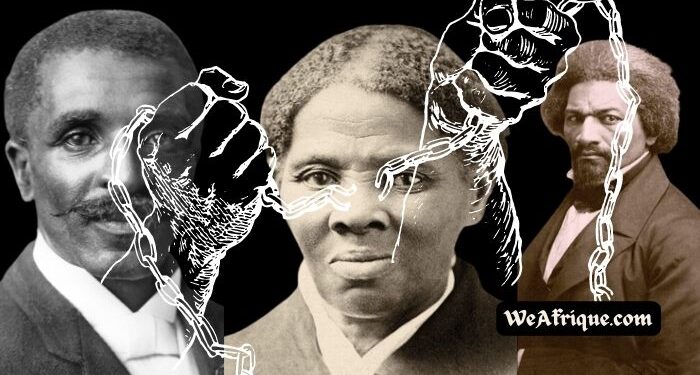From north, south, east, west, and central Africa, several people were taken out of the continent for slavery. Their tales have been told over and time again and have been important to human history. While a number of these slaves did not live to mark their names as icons, others successfully turned their chronicles of pain and shame into legendary stories that have outlived them.
Many of these legends did things that may seem ordinary in the most extraordinary ways. From those who led to the freedom of multiple to those who fought some of the most difficult battles, here are top African slaves that have turned out heroic.
10 Most Fascinating African Slaves Who Became Legendary
1. Harriet Tubman
She was born Araminta “Minty” Ross to slave parents in the 19th century. Long before her birth, her grandmother arrived in America as a slave from Africa. History suggests that her ancestral home is the Ashanti Region of modern-day Ghana.
Harriet lived most of her early life in the hardship of slavery and working with different masters in their homes and fields. She wore scars from beatings and had to endure a broken skull after she was hit by a 2-pound metal weight that was meant to strike another slave.
In her later life, Harriet Tubman was determined to either die or gain liberty. Well, she actually gained liberty when she escaped on a journey of almost 90 miles – that is about 145 km by foot. She finally reached Philadelphia, became free, and started odd jobs.
She became an abolitionist and began her journey to free other family members in Maryland where she escaped from. Tubman would mostly go on her rescue missions during winter to avoid the chances of being seen.
The legendary former slave made 13 trips and led about 70 people to freedom. She also gave instructions that led about 50 to 60 different slaves to northern America and even Canada.
Her expertise in escaping with slaves was second to none and it was only a matter of time before words were passed and she was nicknamed “Moses” – an important figure in some religions that led people to a promised land.
After making her marks that stood the test of time, Harriet Tubman died of pneumonia on March 10, 1913. She inspired people of different races and as a result of her contributions, many people rose to become abolitionists.
Her story has been recorded in many forms such as books and movies. Several things have been created in her honor, including the “Harriet Tubman Underground Railroad National Monument” at Blackwater National Wildlife Refuge by former US President Barack Obama.
2. Anarcha Westcott
She is not like many legendary African slaves who fought battles, led themselves and others to freedom, fought for equity, and moved for the abolition of slavery. So, you may want to ask why Anarcha Wescott made it to this list.
Well, Westcott is vital in the history of gynecology and the cross she carried may have saved millions or more women around the world.
She was an enslaved woman that had to go through a series of excruciating experimental surgical procedures conducted by the man considered the father of gynecology – J. Marion Sims. The surgeries were carried out when she was at least 13 years old, without anesthesia, and also without her consent.
The surgery was in order to treat vesicovaginal fistula (VVF) and rectovaginal fistula.
She has often been labeled a heroine for black women and part of her story has been told through books, poetry, statue and monuments, and music.
3. George Carver
He was born into slavery in the 1800s but his intellectual capability turned him into a great agricultural scientist, inventor, and professor. Unlike many slaves, he had slave masters that protected him. After the abolition of slavery in Missouri in 1865, he was raised alongside his brother by his masters and wife (master’s wife) who treated them as their children and encouraged them to learn.
He recorded history and is still remembered for developing a technique to improve soils depleted by repeated plantings of cotton. He alongside other scientists found ways for farmers to restore nitrogen in their soil by practicing systematic crop rotation.
Carver also developed agricultural extension in the country. Today, the world and America boast of systematic crop rotation which gives better yields and contributes to the quality of life.
His work was publicly praised by the 26th US President Theodore Roosevelt. George Carver, a graduate of Iowa State University was also made a member of the Royal Society of Arts in England.
He died on January 5, 1943, after suffering complications from a stairs fall. He was 79 years old at the time.
4. Gasper Yanga
How can a man be born into royalty and end up as a slave in a foreign land? Well, this is the story of Gasper Yanga who is also known as Nyanga. He was born into a royal family in Gabon before his life of freedom and royalty was taken away from him after he was captured and sold into slavery in Mexico.
But then, there was determination for Yanga to gain his freedom. The movement started around 1570 when he led a band of slaves in escaping to what is now called Córdoba.
Although there are no basic stories of how he carried out his escape and those of many others, there are recordings that black slaves at the time had planned to revolt, kill whites, and have their own ruler.
By the 16th century, the place he had settled with many other black people had about 20,569 population and made up 6% of the general population.
Spaniards retaliated and worked hard to see the end of the black people but it was difficult and there were losses for both parties. The Spaniards later settled with Yanga. One of the agreements was that his family would have the right to rule.
By 1930, there was the establishment of a town called San Lorenzo de los Negros de Cerralvo in present-day Veracruz. The town’s name was later changed to Yanga.
Mexico remembered his deeds in 1871 and was he named a National Hero.
5. Ganga Zumba
Have you ever heard the famous slavery quote that says “I must get my soul back from you; I am killing my flesh without it”? This quote may not have been said by Ganga Zumba but he lived by it either knowingly or unknowingly.
He was from what was formerly known as Kongo and in the present time called Angola in the western region of Congo. Also, he was born as a prince and as the son of princess Aqualtune.
Ganga lost his freedom after his kingdom was conquered by the Portuguese who also took the king, some of his descendants, and other notable people of the kingdom to Brazil.
He served as a slave at the plantation of Santa Rita which is located in northeast Brazil.
His troubled soul nurtured the dreams of escape. Gladly, he was able to flee to Palmares alongside some family members.
Ganga Zumba became a ruler of his people in Quilombo of Palmares before signing a treaty to relocate to Cucau Valley. Some of his people, including his nephew, Zumbi were against it.
The ruler cum former African slave was killed by poison and several of his supporters that moved to Cucau Valley were re-enslaved by the Portuguese.
His story has been recorded in a novel by Joao Felicio dos Santo which was adapted into a 1972-released film, Ganga Zumba.
See Also: 10 Shocking Truths About Slave Trade History In Africa
6. Fredrick Douglass
He was a writer, an abolitionist, a preacher, and an orator who was born to a white father and an African slave mother. His life was that of slavery until he escaped to Philadelphia.
Before his escape, he had already learned how to read and write, first from his master’s wife and later by observing writings from other white people.
The mixed-race former slave was focused on getting black people their freedom and started his first abolition newspaper called the North Star. Douglass used his writing prowess to further show clearly that black people were not intellectually inferior as were made to believe.
He and his wife provide shelter for more than 400 escaped slaves and did not hide his feeling for African American children to receive an education. The abolitionist was also a great supporter of women’s rights.
He is mostly remembered for his What to the Slave is the Fourth of July which has been described as one of the greatest anti-slavery speeches of all time.
Fredrick Douglass died of a massive heart attack at the age of 77 on February 20, 1985.
7. Malik Amber
Life may not have started so well for Malik but his later life led to his becoming a legendary man with African roots. He was born in 1548 in modern-day Ethiopia as a free man and was named Chapu.
His journey into slavery started after he was sold by his parents and later ended in Yemen. He was resold several other times before he was lastly sold to an Indian.
His life took an entirely new turn when his master died and his master’s wife freed him.
Amber Malik later became a soldier and served in the Nizam Shahi Army. Little by little, his power grew and he controlled over 50,000 men fearlessly and was also able to defeat kingdoms. In addition, he got to the stage of a Siddi military leader, prime minister, kingmaker, and de facto ruler of the Ahmadnagar Sultanate in India.
History remembers him as one of the greatest black men who controlled territories beyond the shores of Africa.
Nonetheless, his greatness fell in his last days in a series of defeats before his death in 1962 at the age of 77. He was buried in Khuldabad, near the shrine of one of the earliest Sufis of the Chishti named Zar Zari Zar Baksh.
His throne was succeeded by his son, Fateh Khan.
8. Kunta Kinte
The story of Kunte Kinte has been told by American writer Alex Kaley who claims the be a 7th-generation descendant of the former slave. According to his book, Roots: The Saga of an Amerian Family (based on fact and fiction), Haley recounted how Kunta Kinte hails from the Gambia but landed as a slave in America after he was captured.
He died of heartbreak in 1822 after his daughter was sold earlier and his wife was also sold.
Kunta whose name was changed to Toby by his master’s wife became a legend many years after his death. James Island which was a holding ground for captured slaves was renamed after him.
The movie adaptation of his story is the 3rd-highest rated telecast in American history.
Generally, his story became a stronghold for activists in America and contributed to the change in American attitude to slavery,
9. Sojourner Truth
She was born Isabella Baumfree in America and records her name as an African abolitionist and women’s rights activist. Her story of slavery was that of being raped, being denied her right to love, working under harsh conditions, and being passed from one master to another.
However, this story changed when she escaped with her infant daughter, Sophia in 1826 and headed for New Paltz.
Her freedom was not enough as she wanted the same for her 5-year-old son who she left behind and heard that he was sold and resold illegally. The mother took the case to a Supreme Court in New York under the name Isabella van Wagenen.
Luckily enough for her, she won the case and became one of the few women at the time to win a case against a white man.
Although she was later convicted for an alleged murder of a preacher, she gained freedom and preached the Christian gospel, freedom for black people, and equity.
She died of an ailment on November 28, 1883, and different states in America have honored her through monuments and statues.
10. James Somerset
“The Somerset Case” was named after him. It became precedence for many other cases that led to the freedom of black people.
His story started as a free man born in Africa before being captured and taken to America as a slave when he was 8 years old. He was bought by a Scottish merchant named Charles Stewart who moved with the boy to England.
Somerset met abolitionists, Elizabeth Cade and John Marlow. They became his godparents at baptism and he enjoyed freedom for a few months before he was kidnapped to be sent to Jamaica to be sold.
His godparents filed a Habeas Corpus case and on June 22, a Judge, Lord Mansfield passed a verdict in favor of the former slave. The judgment stated that a person cannot be forced out of England, hence Somerset was free.
Although there are suggestions that the Mansfield judgment was believed to have been misquoted, it was widely celebrated. He became a hero of abolition and his case became a driving force in many countries.




















